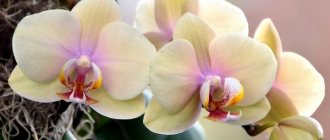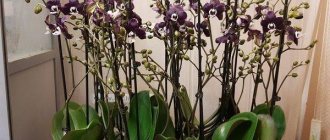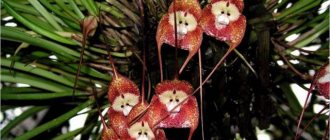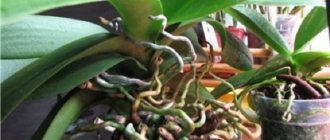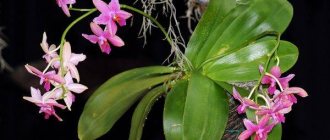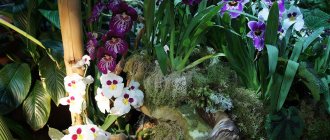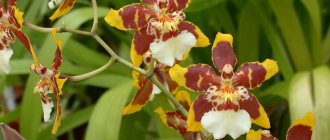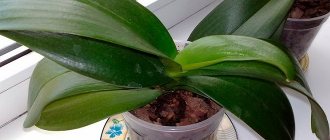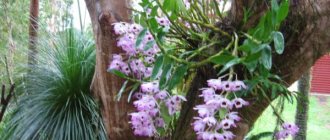The necessary conditions
In order for an orchid to consistently delight with its flowering, it is necessary to take into account its care preferences. Let's take a closer look at what factors influence the flowering of this plant.
Age
The age of the plant plays a very important role , since it begins to bloom naturally no earlier than one and a half to two years (depending on the species). The formation of flowers in a young plant is extremely undesirable, since the flowering process takes a lot of energy and the Orchid may not restore them and die. You can determine how young a plant is by the number of shoots - adult Orchids ready for flowering have about 5-8 of them.
Immobility
It is important to remember that any, even minor, movement of a flower will become a real stress for it, be it simply moving a pot or moving. The orchid reacts painfully to a change of place and, in order to make the adaptation period easier for it, it is necessary to place the container with the plant in relation to the light source in the same way as it was originally (i.e., place the same side towards the sun or lamp). It is also not recommended to move the pot during watering; it is better to leave the capricious orchid alone.
Important! Under no circumstances should you move the plant while the peduncle is forming - this may negatively affect the growth of the flower.
Favorable environment for the development of the root system
The conditions for the development of the root system must be taken care of in advance , because... Orchid does not like unnecessary movements. When choosing a pot, it is better to pay attention to transparent plastic containers with a large number of drainage holes. Transparency is welcome, since the roots are actively involved in the process of photosynthesis and need good lighting. It is better to avoid ceramic dishes, because the roots can grow to uneven surfaces and be injured by sharp protrusions.
Lighting
For normal flowering, the plant needs full daylight - at least 10-12 hours a day, so in the autumn-winter months it will be necessary to maintain lighting with the help of special lamps. Peduncles released in autumn or winter may die due to lack of light, and this cannot be allowed. A good solution would be to purchase phytolamps. They provide excellent illumination to plants and do not dry out the air around them.
Without additional lighting, the peduncle may stop growing and die. If it is not possible to artificially illuminate the entire flower, it is enough to direct the light of the lamp to the tip of the peduncle, but so that neither it nor the plant itself is exposed to heat.
Air temperature difference
For many Orchids, a slight difference in air temperature is important , i.e. at night the temperature should be 4-6 degrees lower than during the day. You will have to be very careful and make an effort to comply with this point.
During the warm season, you can place plants outdoors, where the temperature will be regulated naturally. In cold weather, it is necessary to regularly ventilate the room decorated with this capricious flower, but so that the plant does not end up in a draft that it cannot tolerate.
Watering
To avoid rotting of the root system, it is recommended to water the orchid after the soil has completely dried , both in summer and winter, regardless of whether the plant is an adult or a young one.
At the same time, after flowering ends, it is necessary to reduce watering for about a month. This is an important point due to the fact that in the wild, after flowering, the Orchid begins to set seeds, which, after ripening, should scatter for kilometers around. Scattering is possible only in dry weather, so reducing watering is, first of all, creating conditions close to natural.
Air humidity
Air humidity is important for plant growth and development . If the air around the Orchid is too dry (this most often happens during the heating season), the flower stalks may stop developing and dry out. You can maintain a favorable microclimate using a simple container filled with water and placed near pots with plants. In addition, you can and should spray the flower, providing it with additional moisture.
Reference! The recommended air humidity for Orchids is 60% or more.
Fertilizers
Properly selected fertilizer will greatly facilitate the flowering process. Fertilizer compositions based on potassium and phosphorus, which stimulate the formation of flower buds, are favorable for Orchids. In addition, the useful elements included in the fertilizer will ensure the growth of strong and healthy flowers. But you should not experiment with compounds containing a large percentage of nitrogen, as they will inhibit plant growth.
You can learn more about what fertilizers orchids need to stimulate flowering by watching the video:
Stressful situations
This may seem strange, but sometimes in order for a plant to bloom, it is necessary to “scare” it .
There are times when the Orchid is too happy with the conditions and puts all its forces into the development of greenery, without releasing the flower arrow. On the one hand, this is good - the plant is healthy and happy, but on the other hand, you want aesthetic pleasure. You can move the pot to a cooler place or reduce watering. Having experienced a slight shock, the Orchid often returns to normal and blooms.
How do different types of plants bloom?
Most often, an orchid is presented already in bloom as a gift. After the flowers fall, it seems that it is impossible to achieve flowering at home, and the orchid is perceived as “disposable.” But in fact, flowering depends largely on plant care, and this is a whole science.
Cymbidium
You can hear quite conflicting opinions about this genus of plants of the Orchidaceae family. Some will say that this is too whimsical a flower for beginners, while others, on the contrary, will suggest this particular species for novice gardeners.
Reference. The whole difficulty is that it is quite difficult to force cymbidium to bloom, but it is steadfastly ready to endure improper care for it.
Among all orchids, this species is the “king” of fragrant flowers. You can verify this if such a plant stands in the room. Depending on the type, there are flowers with a scent:
- honey;
- lemon;
- raspberries
Botanists also developed different colors of cymbidium:
- snow-white;
- yellowish;
- green;
- and even red ones.
Most often, flower stalks of this species begin to appear at the end of summer. The appearance of a peduncle is heralded by a thickened aerial part of the stem, which is called a pseudobulb. After flowering, the cymbidium does not bloom for some time and freezes.
During this period of “rest,” it is better to lower the temperature to about +10 degrees and make watering more moderate. In some species, such dormancy can last until February, and in others until early spring.
Phalaenopsis
Phalaenopsis is one of the most common types of orchids. And it’s not surprising, because this species pleases with its flowering for quite a long time: from two to six months. Flowering occurs twice a year, and sometimes even three times a year.
Important! The diameter of flowers can reach from two to fifteen centimeters. The number of flowers on one peduncle can be very different: from three to forty pieces. It depends on the condition of the plant and its branching.
The color of the buds, like that of cymbidium, is varied:
- white;
- dark purple;
- yellow;
- with various specks and spots.
After flowering has finished, under no circumstances should you trim the peduncle. Perhaps the next flowering period will come from the old peduncle. You can cut it only if it is completely dry!
Dendrobium
One of the richest types of orchids to bloom is dendrobium. Its stems are abundantly strewn with flowers, and the leaves are arranged alternately on the stem. The peduncles of this species grow from the axils of the leaves, and each peduncle usually has four flowers.
Attention! Dendrobium blooms most often from autumn to spring. But this is exactly the species that can produce flowers at any time of the year. The color of the buds can be white, pinkish or lilac.
Other types
In fact, the orchid is a rather capricious plant, and caring for it is a whole science. Each orchid variety requires individual care. But in general, the flowering period varies from two to six months a year, depending on the type of this tropical plant. At the same time, the plant can delight with its flowers at any time of the year, even in winter.
As always, flowering begins with the appearance and opening of buds. For orchids, this is a long process: first the petals open on the sides and top, then the middle of the bud. The active growth of the flower continues for a few more days, and only then can the peak of the bud bloom be observed.
Blooming periods
There is no clear answer to the question “How often do Orchids bloom?” , since many factors influence this process. Plant types are diverse, with their own advantages and disadvantages, characteristics and needs.
With proper, systematic care, an Orchid can send out flowering arrows twice a year, or it may not bloom at all. Do not forget that after the flowering period there comes a period of rest. How long the plant needs to recuperate determines when the next buds will appear.
What to do when the orchid has bloomed
Unfortunately, the orchid will not be able to bloom forever - as we have already found out, flowering is the period preceding reproduction. Therefore, when phalaenopsis fades at home, it is important to take care of the plant, providing it with good conditions for the dormant period.
The question often arises regarding the need to trim the peduncle. There is no clear answer here. The plant either immediately dries it out or leaves it for the baby to develop. Of course, a dried peduncle is useless and has a completely unaesthetic appearance. Therefore, you can safely remove it and wait for a new flowering.
As for the living peduncle, there is no need to cut it off completely. There are three options for further developments:
- the orchid will release a side shoot and new flowers will bloom on it;
- the plant will grow a baby, so the peduncle is needed to nourish it;
- the phalaenopsis itself will dry out the stem it does not need.
In any case, it is necessary to trim the peduncle a little. For this you will need:
- Sharp tool: scissors, guillotine or stationery knife.
- Alcohol and cotton wool for sterilizing instruments.
The cut should be 1 cm above the first dormant bud. The cut does not need to be treated with anything, just let it dry naturally. Of course, you can’t get it wet either. The dried peduncle is cut 1 cm above the growing point.
How long does it last
Reference! On average, the flowering time of an Orchid is about three months. However, this process can either be extended or shortened in time.
Why did the Orchid bloom little:
- When buying a flowering plant, you need to take into account the period of time that the flower spent on the display case. In other words, it is likely that the Orchid has been blooming for a long time and you should not be alarmed if the flowering plant you purchased at home quickly loses its buds.
- Too dry and warm air also does not contribute to long-term flowering, so you should carefully consider the conditions in which the beauty is kept.
- Excessive watering negatively affects the root system. A sick plant is always in a hurry to get rid of its flowers.
In some cases, with a successful combination of circumstances and quality care, Orchids can bloom for eight months or more (there are flower growers who claim that the flowering process can last almost all year round).
Blooming Orchids purchased in winter often delight with their buds for a long time . This is due to the fact that after the main flowering, under the rays of the spring sun, dormant buds can become active, often giving life to new flower stalks.
The more flower stalks you buy, the more likely it is that the flowering process will be long. In addition, flower stalks can bloom either simultaneously or one by one, which also extends the flowering period.
Features of orchid flowering
"Phalaenopsis" are the most adapted to indoor growing. The frequency of flowering of a plant depends on the type of properties inherent in the breeding process. The flowering time of "Phalaenopsis" lasts about three months and depends on the absence of the influence of negative external factors during the growing period.
The first condition, if not met, the plant will not bloom for a long time, is a lack of light. "Phalaenopsis" can be content with a filtered type of lighting. It should be remembered that it is one of the orchids with the longest flowering period. It really lasts a very long time.
The Lady's slipper orchid has about 80 species, including terrestrial and semi-epiphytic. Unlike a significant number of orchids, the Lady's slipper species does not tolerate acidic substrates. To increase the alkaline content of the substrate, it is customary to add lime. Lady's slipper is most often grown in the open ground of front gardens. "Paphiopedilum" or "Lady's slipper" is one of the most beautiful orchid species for the temperate zone.
It should be remembered that sometimes plants that have not been replanted for several years grow all year round. Some species grow and rest for two years before flowering. If your indoor orchid has never bloomed before, then it’s worth finding out how old it is. All species of this plant have their own flowering times.
It must be remembered that with proper care, after a while the flower can bloom again. The main problems are observed if the plant does not begin to form buds and bloom for a long time. You can draw a conclusion about the need to stimulate flowering after determining the cause.
Is it possible to artificially stimulate?
Attention! As mentioned earlier, it is not recommended to artificially stimulate the flowering of a young plant, because there is a high probability of his death. However, there are several ways to get your Orchid to bloom, as long as the plant is healthy and well cared for.
Ways to stimulate flowering in orchids:
- Organize a temperature difference by placing the pot in a cooler place at night and in a warm place in the morning. After stress, flower arrows often appear.
- Make changes to the irrigation system.
- Use additional means, such as “Plumen”, “Bud”, “Ovary”, etc.
The most desperate flower growers use hot showers as a means of stimulating flowering. The process consists of rinsing the plant under running water at a temperature of 40-45 degrees. Several approaches of 10 seconds with breaks of 15-20 minutes almost always help to cheer up a stubborn Orchid. Sensing danger, the flower seeks to leave offspring by releasing arrows. This method is not recommended and is used in the most difficult cases.
What else can you do?
To bloom, orchids need to be given a little “stress.” Too comfortable conditions can slow down the onset of flowering.
Drought simulation
Since there is a season without rain in the tropics, this natural phenomenon can be repeated at home to make the orchid feel at home. When creating a drought, consider the following:
- frequent watering has a good effect on leaf growth, and vice versa: drought can easily provoke flowering;
- during drought, the room temperature should not exceed 30 degrees;
- the interval between waterings is doubled; the plant should not be sprayed or watered;
- As soon as the flower arrow appears, care continues as usual.
Attention! If the plant is weakened, then the drought method should not be used. Otherwise, the plant may die.
Warm shower
Keep in mind that showering too warm can harm the plant. Recommended water temperature is 40–50 degrees. It is the leaves that should be watered, so the pot must be covered with film. Gently water the orchid leaves for about 15 seconds. You can repeat the procedure every week and a half, with the exception of the winter season.
Simulation of the rainy season
Another way is to create an artificial rainy season. The water for this procedure should be warm, approximately 35 degrees. You need to water it 4 days in a row, you can even use a shower for this. Then the roots of the plant should dry out (about two weeks), at which time watering should be stopped. Then you can return to your previous watering pattern.
Use of chemicals
Sometimes orchids can be pampered with some fertilizers. This will give the plant energy and stimulate flower growth.
- Succinic acid. This is a natural substance that will help strengthen the protective functions of the plant. Thanks to it you can achieve:
- active foliage growth;
growth of new flower stalks;
- orchid disease resistance;
- The lifespan of a flower increases.
- Cytokinin paste. But this is a phytohormonal preparation, where the main phytohormone is cytokinin. Thanks to this paste you can achieve the following effect:
- Dormant kidneys awaken;
- flowering is significantly accelerated;
- metabolism is restored;
- flowering is prolonged.
You can use succinic acid for watering, spraying or even soaking seeds.
The following video shows how to use cytokinin paste to stimulate flowering:
Recommended products
Here are the main preparations developed for orchid flowering:
- Bona Forte (Bona Forte). A series of fertilizers that help maintain plant health. It contains all the necessary substances.
- Agricole. Multicomponent mineral fertilizer is a gel that is designed specifically for orchids.
- Dr. Foley. This drug is used to spray leaves, which is very convenient. Contains essential microelements, phytohormones, amino acids and vitamins.
- Brexil Combi. Designed specifically for plants that lack iron. It is recommended to spray the orchid with this preparation once every three weeks.
Yes, the orchid is picky, and it requires a lot of time for itself. But the orchid bloom is definitely worth the effort. If you do everything correctly in care, the plant will definitely reward you with lush and abundant flowers.
How does it begin to open up?
In the axils, between the leaves, on the stem of the plant, there are dormant buds, which, under conditions close to natural (with normal care), can develop into a peduncle or give off lateral shoots. Sometimes inexperienced gardeners confuse flower stalks with aerial roots.
It should be remembered that the flower-bearing arrow always develops from the growth point . The peduncle can bend bizarrely at the beginning, and then stretch out quite high. At the top of the flower-bearing arrow, bulbs are formed, which subsequently open into beautiful delicate buds.
Important! During the formation of the peduncle, under no circumstances should the Orchid be subjected to stress.
In the case of the simultaneous appearance of a peduncle and a new leaf, it is best not to interfere and let the plant independently choose what is best for it to develop.
The need for stress
In some cases, the best incentive for an orchid to bloom is a little stress. Sometimes you can observe that all the conditions for flowering have been created, but the plant still does not want to shoot. The reason for this is that the orchid feels too good. Under such circumstances, it directs all resources to increase green mass. To stimulate flowering, you need to slightly “shock” the plant by reducing watering or moving the container in which it is located to a cooler place. When using this method, you need to take into account that the stress should not be too severe, otherwise it may be detrimental to the plant.
Photo
Further in the photo you can more clearly see the flowering of the beautiful orchid:
When and how often?
In favorable conditions, phalaenopsis produce 2 waves of flowering, the duration of each of them is up to 3 months. Upon completion of the first wave, the plant has a short break (no more than 2 months), after which flowering begins again. In the presence of artificial lighting, orchids bloom regardless of the time of year. Without additional lighting, the process is cyclical:
- spring – the beginning of the first phase;
- mid-summer - the formation of new buds after the end of the first phase, the appearance of lateral buds on old peduncles;
- the last days of summer and the beginning of autumn - the second phase of flowering;
- winter period - break.
Features of home care
An orchid is a capricious plant that needs constant care.
- Care before flowering.
During dormant periods, before the Orchid blooms, measures to care for it come down to regular watering, maintaining optimal lighting, temperature and humidity, and fertilizing. If the plant has been transplanted, it must be watered immediately.It is recommended to boil water for irrigation and add potassium or magnesium to it as a top-up. It is best to immerse the flower pot in the prepared solution and leave for 30 minutes. In the future, water as needed after the soil has completely dried.
- During flowering .
At the time when the orchid begins to bloom, until the buds open, it is necessary to water the plant thoroughly and spray the aerial roots with warm water. Lack of moisture can cause the peduncle to dry out. The air around a blooming orchid should be moist and clean, so you need to regularly ventilate the room without creating drafts. When the buds open, watering is reduced. - Care after flowering.
At the end of flowering, old flower stalks are cut off so that new ones can fully form. Do not rush with this procedure; it is necessary that the arrows dry thoroughly, otherwise the pruned plant may get sick.Some Orchids spend a little time recovering, blooming again. In this regard, after flowering it is necessary to intensively feed the flower with special compounds. This will allow the plant to gain strength faster and improve its overall condition. Between flowering periods, Orchid care is carried out as usual.
You can learn more about how to care for your orchid during and after flowering in a separate article.
Reasons why an orchid does not bloom
There are many factors that affect a flower's ability to bloom. We roughly divided them into two groups.
Improper care
If you brought an orchid from the store, it has faded and no longer wants to, you probably created unsuitable conditions for it. Find out how to grow it correctly in the article “How to care for an orchid in a pot and in a bouquet.” Typical mistakes:
- Flower not enough light
. Move it to another room or buy a phytolamp.
- Constant room temperature
. For shoots to appear, temperature changes of 5-7 degrees are needed: cool at night, warm during the day.
- The soil is overdried
. If an orchid blooms with a lack of moisture, it will die.
- To the plant lacking micronutrients
. Potassium and iron are important for flowering. If they are not in the ground, energy goes into survival. Buy special fertilizer from a gardening store.
Monitor the nitrogen content. It is destructive to tropical flowers.
- Incorrect soil
. It must contain admixtures of wood, since many orchids are epiphytes and live on trees.
Features of an orchid
A flower may also have individual reasons
be capricious. Let's list the most common ones:
- Root system rotting
. In the salon where you bought the flower, it may have been poorly cared for, and the roots are affected by fungus or infection. You can find out this during transplantation. When the orchid has finished blooming, replant it and inspect the roots for damage. Remove dysfunctional roots.
- Orchid is weakened
: It was recently replanted or there was no dormancy after the last flowering.
What to do if the arrow does not release?
It is not uncommon for an Orchid to categorically refuse to bloom. It can turn green for years, but not produce flower stalks, and this undoubtedly upsets the owners of the capricious plant.
Reasons for lack of flowering:
- Lack of light, especially in cold months.
- Incorrect watering scheme: too much or not enough.
- Temperature violation.
- Dry air.
- Lack of nutrients.
To force an Orchid to release a flower arrow, the two most reliable methods are usually used:
- Reduce the amount of liquid when watering.
- They create a stressful situation by lowering the air temperature.
As a rule, these methods work, the plant is “scared” and strives to reproduce, and the gardener enjoys amazing flowers.
We invite you to watch a useful video about what to do to make an orchid bloom:
Plant age value
If a recently purchased non-blooming orchid is in no hurry to release a flower arrow, the reason may lie in its youth. Depending on the variety of this plant, it begins to bloom at the age of one and a half to three years. To determine the age of an orchid, count the number of shoots. In an adult plant that is ready to bloom, it should be between five and eight. Premature appearance of flowers is undesirable, since a too young plant may not be able to recover after flowering, which means that it will die.
Is it possible to extend the time in bloom?
The surest way to extend the flowering time of an Orchid is to properly care for it. Any deviation from the norm can lead to withering and falling off of the buds or drying out of the entire peduncle.
Factors that allow you to control the flowering process:
- Different air temperatures during the day and night.
- Duration of daylight hours, i.e. increasing it if necessary.
You can control the flowering process from the moment the buds form until the last flower fully blooms.
In conclusion, I would like to note that all plants need special care and if the grower is not ready to create favorable conditions for each ward, you should not expect outstanding results. Regarding Orchids - only patience and attentiveness will allow you to grow a strong and healthy flower.
Proper watering
The orchid should be watered after the soil dries to prevent rotting of the root system. This is true equally for adult plants and for children, both in winter and in summer. But there is one exception: after the orchid has finished flowering, you need to stop watering for about a month. Under natural conditions, after flowering, these plants set seeds that scatter in different directions over a distance of several kilometers. This is only possible in dry weather. So you should create conditions for the orchid that are as close to natural as possible - then it will remain healthy and bloom often. Before and during flowering, the orchid needs more intensive watering compared to the dormant period.
